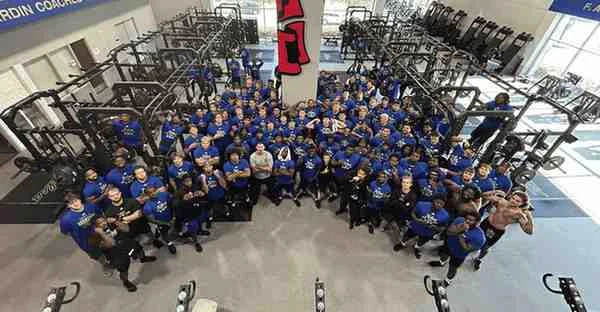
[freelap-altis-logo]
The conversation around culture is longstanding, and I had every intention of staying away from it. However, with the guys at HMMR Media doing a recent month-long deep dive reading Daniel Coyle’s The Culture Code, and a few lengthy discussions around culture in consulting initiatives of late, I couldn’t help but put something on paper.
Fortunately, the relevance of culture cannot be overstated, even in the digital age where we find ourselves. Success in any organizational objective is often dependent on the culture that surrounds it. It can be the make-or-break factor for young companies or the painful demise of well-established organizations.
Success in any organizational objective is often dependent on the culture that surrounds it, says @jhettler24. Share on XALTIS is often credited with having a world-class high-performance culture. Therefore, we get a lot of questions about building and maintaining culture at our on-site education programs, as well as when we travel for various speaking engagements. These conversations always come back around to three key tenets: people, language, and philosophy. Understanding the crucial interrelationship between these three building blocks and maximizing each of them is the first step towards a successful high-performance culture.
People
The first step, although obvious, is always worth mentioning. Getting the appropriate people involved is the cornerstone to any culture. It is up to leadership to open the door to appropriate candidates and close the door to those who do not add to the overall environment.
Getting the appropriate people involved is the cornerstone to any #culture, says @jhettler24. Share on XThis decision-making process should not be based solely on intellect, experience, or specific skill sets; rather, the framework should be based around shared values and strong emotional bonds. This model, described as the “Commitment Model” in The Culture Code, appeared at a higher rate in Silicon Valley start-ups that survived the tech bubble burst of 2000 and that achieved IPOs three times more often (Baron and Hannan, 2002).
This is a very important consideration, as increasing an individual’s abilities is a much more attainable goal when compared with attempting to shift their values and forge emotional bonds. Therefore, highlight more than traditional qualifications and previous experiences when adding new team members and give serious consideration to any potential positive or negative effect on team dynamics.
A tougher but equally important strategic move that goes hand in hand with opening the door to the right individuals may require separation from currently involved team members. Disruption to team cohesiveness cannot be tolerated. The short-term inconvenience of separating from a toxic team member should not overshadow the compounding investment of improving culture.
Without the right pieces in place, the achievement of an ideal culture becomes difficult, if not impossible. Unfortunately, you do not always have the ability to make staffing changes. At times, shifting an already established culture among a team of individuals is the only route.
When this is the case, slow and steady wins the race. It is ill-advised to step into a situation and make drastic changes right away. Planting seeds and allowing the rest of the team to identify the need for a culture shift “on their own” can be a highly effective tactic. Ensuring all members are onboard and buy in prior to large-scale adjustments will ease the process for all involved.
Language
Once the right people are on board, it is imperative that they are all capable of “speaking the same language.” Interdisciplinary teams are vital to high-performance success. With this, any barriers between departments (coaches, scientists, medical, etc.) need to be removed.
Interdisciplinary teams are vital to high-performance success, so they must speak the same language, says @jhettler24. Share on XFrom my work with various organizations, it is clear that this is the most common hurdle experienced. One suggestion to help clear up this issue is to create a “glossary of terms” for your organization.
Have each department identify and define key terminology that they need the individuals from other disciplines to understand in order to have an efficient and effective conversation. Compile all the submissions into one document and disperse throughout the organization. Hopefully, this glossary will serve as a starting point for an integrated support team that speaks the same language.
Along with understanding key terminology, the art of communication is key. While much has been discussed on how to communicate effectively, the topic of what to communicate is typically taken for granted. As mentioned, the group at HMMR Media spent the month of March diving into the discussion on culture. One of the pieces that stuck out to me stated, “Communicating clearly defined expectations is key to establishing a training culture.” You can avoid a lot of hiccups by ensuring all involved parties have a clear understanding of the expectations, both for themselves and for others.
We can take this a step further, into one of the key tenets from Extreme Ownership by Jocko Willink and Leif Babin: “It’s not what you preach, it’s what you tolerate.” There is often a disconnect between these two items, with individuals preaching one thing but tolerating another. I often find myself at fault, particularly handling millennials and their phones during training!
To tie it together, understanding the role of language is critical to a high-performance culture. Ensuring all parties involved speak the same language, understand expectations, and hold each other accountable will help you maximize the profound effect language can have.
Philosophy
The final piece to the puzzle involves having a clearly defined performance philosophy. At ALTIS we often talk about the “4 Ps,” which are adapted from Mladen Jovanovic’s “zoom levels.” Here, philosophy underpins the remaining Ps: planning, periodization, and programming. Because the majority of performance-related fields are relatively young, having a philosophy will help practitioners navigate an ever-evolving landscape.
As Alexander Hamilton first stated, “Those who stand for nothing will fall for anything.” With the continuous buzz about the “next best thing,” a philosophy will help you think critically and it can serve as the first line of defense against any fads or gimmicks.
A philosophy will help you think critically and also serve as a defense against fads and gimmicks, says @jhettler24. Share on XAdditionally, developing a philosophy will ensure continuity of the interdisciplinary performance team by creating a guidebook to make the daily adjustments necessary when working with highly complex and dynamic biological systems. This is something I can attest to from personal experience.
When I first began working at ALTIS, the environment was sometimes overwhelming. Thinking back to the philosophy helped me make sense of the chaos and expedited my on-boarding process. It allowed me to make program adjustments on the fly when other, more experienced staff members were tied up.
Continuous restating of an organization’s purpose and how they intend to meet that purpose can have an extremely positive effect on productivity. As previously mentioned, this is particularly true when the individuals involved possess shared values and strong emotional bonds. Never shy away from an opportunity to insert this message, and consider creating catch-phrases that speak to the philosophy and serve as constant reminders.
As an example, at ALTIS we have adapted the phrase “discipline equals freedom,” again from the book Extreme Ownership. The athletes now understand that when they exhibit the necessary discipline to understand their training programs, from warm-ups to workout elements to recovery protocols, they will be afforded the freedom to progress in a timely manner. When all members have a clear understanding of priorities and objectives, they experience more freedom to make necessary decisions in an effective and efficient manner.
Adding Value: A Call to Action
It holds true that the whole is greater than the sum of its parts. In this context, “parts” refers to people—the first building block—and the “whole” is the culture. By adding value to the individual, we create a greater culture.
When you add value to the individual, you create a greater culture, says @jhettler24. Share on XSo how can we add value for all individuals who make up the collective culture? The components of Deci and Ryan’s Self-Determination Theory—relatedness, competence, and autonomy—provide a great starting point.
- Highlight relatedness by targeting shared values and strong emotional bonds.
- Increase competence by developing a glossary of terms for your interdisciplinary team.
- Promote autonomy through the construction of a clearly defined performance philosophy.
Let these steps serve as the initial stages to constructing the framework of a highly motivated and optimally functioning organization. Just remember, culture is as dynamic of an entity as humans themselves. Consequently, you must be prepared for an ever-shifting landscape that will require constant tinkering to reach and maintain optimization.
[freelap-altis-360]





2 comments
Nic Catterall
Well written Jason! As always, imparting ones knowledge in written formats is a hard thing, the message you’ve put forth about culture is a standout one that many should take note of, you’ve done a great job. In my mind, At the end of the day it comes down to how we want our athletes to treat us and how they can expect to be treated by their coaches and staff. Good communication seems to be a hard objective to achieve as more and more people aren’t practicing it on the regular and the the true meaning appears to be lost to many. However many like yourselves and Altis are breathing life into The industry by setting the bar and the key aspects you’ve spoken about in your article.
Keep striving, keep adapting and continue to refine good practices to keep the rest of the industry on its toes.
As you stated…
“Culture is as dynamic as humans themselves”
Ryan Vigneau
Great write Jason! It was evident while at Altis the cohesiveness and respect amongst the coaches. Thanks for putting it on paper.